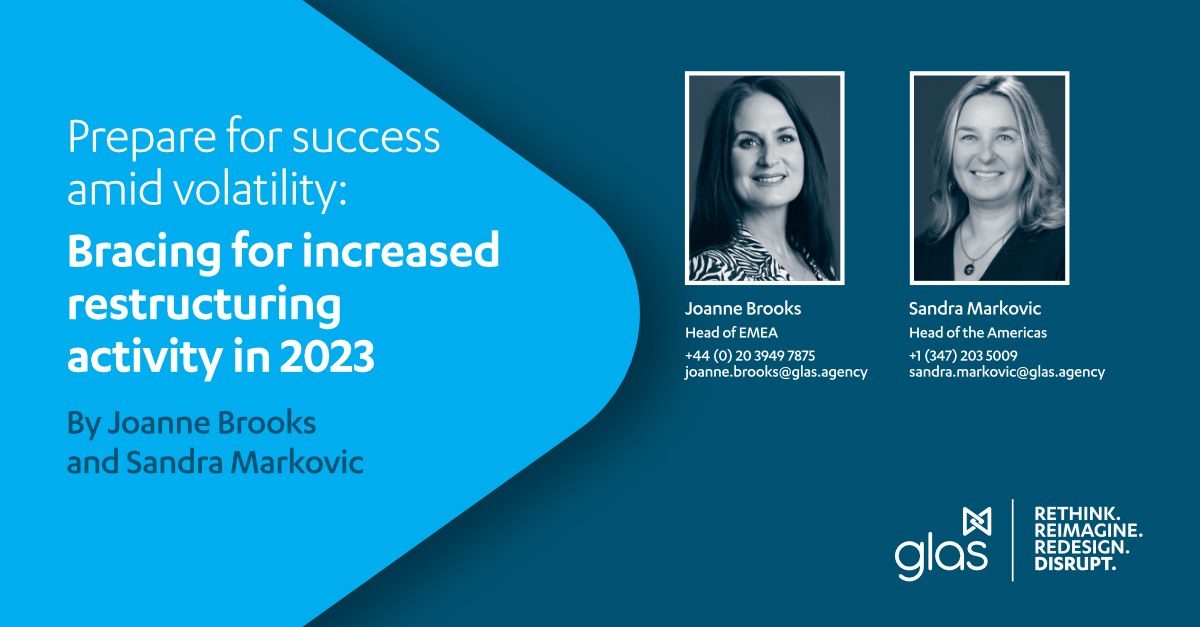By Joanne Brooks, Head of EMEA, and Sandra Markovic, Head of the Americas
Despite expectations for a wave of pandemic-related restructurings in 2021 and 2022, many businesses have shown resilience which, coupled with favourable market conditions, has resulted in very few situations developing. Restructurings for large companies have been particularly rare recently.
Those that did come to fruition have mainly occurred with businesses that were already showing signs of distress pre-pandemic or in industries experiencing significant competitive disruption. However, the macroeconomic environment is changing rapidly amid mounting recessionary pressures, and many businesses could find themselves facing increased distress during 2023.
Some businesses that may have experienced distress previously had their runway extended due to several factors, including central bank stimulus that supported ample availability of capital and lower interest rates that made it easier to refinance debt. Flexibility among lenders also allowed borrowers to secure extensions on payments.
Now, a combination of forces—including tightening monetary policy amid inflation, interest rate hikes, geopolitical conflict, deteriorating consumer confidence and less leniency from risk-averse lenders—points to a sea change for restructurings. Distress levels will likely continue to rise in 2023, so it’s critical for parties to proactively engage in discussions early on and establish the various restructuring options that may be available to companies in distress—should they be forced to formally address their balance sheet.
Spotlight: Uptick in corporate distress after period of rapid recovery
UK and Europe
In the UK, bankruptcy activity during H2 2020 and Q1 2021 dipped to the lowest level in more than 30 years, but it had more than doubled year over year by Q1 2022, and it reached the highest level since 2009 in Q2, according to data from The Insolvency Service. Overall in 2022, insolvencies increased by 57% year over year across England and Wales, 41% in Scotland and 106% in Northern Ireland.
Restructuring activity and insolvencies are poised to continue rising in the UK and across Europe in 2023. Market data indicates that corporate distress in the second half of 2022 rose to its highest levels in two years, driven by deteriorating macroeconomic conditions and tightening of monetary policy by the European Central Bank and Bank of England. Heightened pressure on retail, consumer goods and real estate companies in particular have led to increased signals of distress on the horizon for those sectors.
United States
The pandemic drove U.S. bankruptcy filings in 2020 to the highest levels since 2010, per S&P Global Market Intelligence data, but bankruptcies peaked in July that year and had decreased by 50% as of December. The trend continued as 2021 was the slowest year for bankruptcies since before the 2007–08 global financial crisis. In 2022, there were even fewer bankruptcy filings than the previous year—despite inflation hitting 40-year highs and the Federal Reserve making several consecutive jumbo interest rate increases.
However, there are indications that the dip in activity may be a calm before the storm. Bankruptcy filings in H2 increased by 20% compared to H1, and December saw by far the most filings of any month with 26% more than the second-highest monthly total. That upward trend in the U.S. shows no signs of abating.
The rising cost of debt and the burden of restructuring
With considerable uncertainty ahead, debt has already become significantly more expensive, and that trend is expected to persist throughout 2023. Conditions in credit markets have been broadly favorable for more than a decade, but growing volatility and rising interest rates have caused a significant shift.
Companies with current floating rate facilities will find it increasingly difficult to meet interest burdens, so they will need to reduce liabilities or look at options to shrink their debt. Lenders will also be much less willing than previously to extend new loans, and those that do will not offer the lenient covenant structures that had become common previously, while at the same time interest rates will not be favourable.
Companies in these types of situations can look to begin conversations with their creditors through bondholder identification exercises. Once a group of lenders have formed an ad hoc group to launch a lock-up process, it is also not uncommon to gather more support for a proposed restructuring from other creditors yet to come forward.
GLAS has significant experience in launching and tabulating these events via our bespoke real-time portal, and we would be happy to offer a demo to highlight the value of that technology offering.
Contact us to learn more about the GLAS portal.
These economic conditions may also coincide with more distressed sellers, which would offer M&A opportunities for well-capitalised competitors and financial sponsors. Spin-offs and divestitures of non-core business units can also help distressed companies reorganise more effectively, which present additional opportunities for buyers.
There is an increased administrative burden for deal parties involved in complex restructurings and insolvencies, as well as for bankruptcy litigation, distressed M&A and debt/equity conversions. Lenders, bank agents and trustees often prefer not to deviate from their standard role, and they may not have the deep experience or resources to address these situations efficiently. Proactively bringing in a third-party agent like GLAS sooner can significantly help to reduce the burden—especially if enforcement is needed—so that lenders and advisors can focus on their primary business functions during volatility.
Additional complexity with DTC transactions
There is even more complexity in transactions involving the Depository Trust Company (DTC), particularly with cross-border transactions. In some cases, larger restructurings may have outstanding bonds issued through DTC. That is the case even for court-supervised restructurings that go through the UK scheme or other European systems.
Bonds issued through DTC entail a substantial additional administrative burden. Those bonds may be marked down and then new bonds can be issued elsewhere—or even through DTC again. Consent declarations could be needed from bondholders as well.
GLAS is the only independent agent with DTC capabilities in the UK due to our dedicated New York office. Through our DTC experience, we can anticipate and preempt some questions. We can then address those potential issues through documentation and information packs that facilitate the process to reach an expedient resolution.
Preparation can make all the difference
Faced with an anticipated increase in complex restructurings, it is critical for lenders, lawyers and advisors to take proactive steps. Making preparations now and considering an independent third-party agent can significantly limit the administrative burden. An experienced, responsive agent can make a notable difference and help resolve transactions more quickly, which is particularly important if transaction volume continues to rise.
More information
For more information about how GLAS can help reduce the administrative burden of complex restructurings, contact our Head of EMEA Joanne Brooks or Head of the Americas Sandra Markovic.












